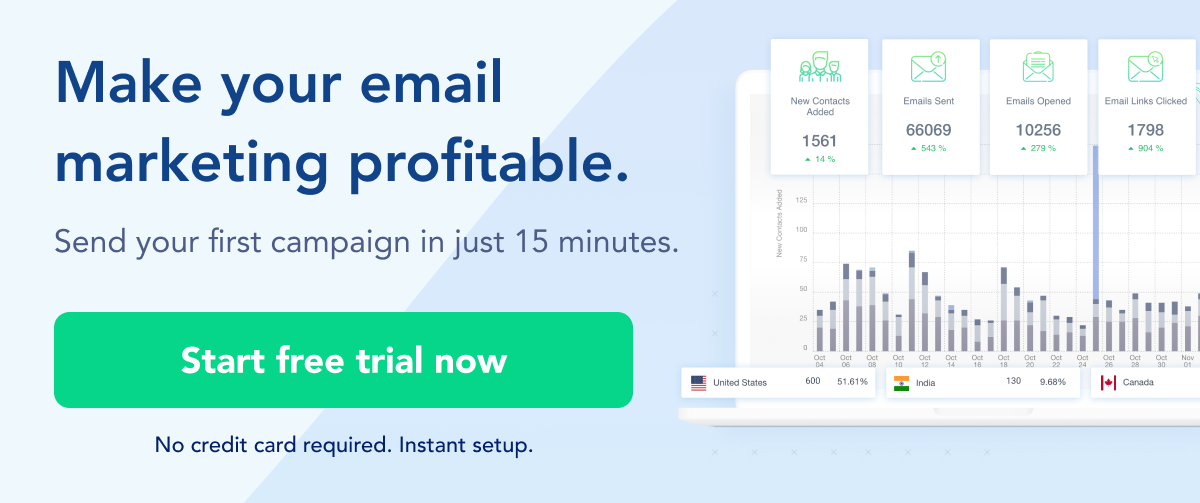
How to Use Email Promo Codes to Great Effect
Who doesn’t love being on the receiving end of a great email discount code? For most of us, they’re a sure-shot way of buying the product.
However, being on the other end of these promo codes (aka to be the ones strategizing, curating, and designing these email codes) can be rather difficult.
You’ve got to figure out what your reader likes/dislikes, how to segment your audience, and what to do once you’ve sent those coupon codes.
So, we’ve outlined an eight-step process on how to design email promo codes and use them effectively.
Table of Contents
- Step 1: Understand Your Audience
- Step 2: Segment Your Email List
- Step 3: Craft Compelling Email Copy
- Step 4: Design Visually Appealing Emails
- Step 5: Implement Urgency and Scarcity Tactics
- Step 6: Track and Analyze Promo Codes
- Step 7: Integrate Promo Codes With Email Automation
- Step 8: Manage Expiry and Redemption Policies
- Next Steps
Step 1: Understand Your Audience
The first step of the process, as it usually is, is to understand the needs, wants, and preferences of your audience in and out. It also means you might need to:
- Find out their common pain points from customer-facing teams like sales and customer support
- Interact with them (through social media channels or other mediums)
- Analyze their conversations on community forums.
Doing so will allow you to find out what makes your customers tick (go away from your website) and click (go forward with your coupon code offer).
Based on these insights, you can begin developing email promo codes and offers that either alleviate these pain points or can be something they think of as a reward.
For example, if you’re a banking company and you realize most of your customers are wary of paying bank account opening charges, you can offer promo codes that offer a special free bank account.
Source: <Chime>
Step 2: Segment Your Email List
Different subsets of your customers might also have different preferences based on their demographics, industries, incomes, etc.
So, the next step for maximizing the effectiveness of promo codes is to segment your email list based on a common factor: e.g., this segmentation can be based on the location of your customers, how frequently they open your emails, the industries they operate in, etc.
More often than not, companies prefer segmenting their email audiences based on the following:
- Purchasing Style
- Demographics
- Activity Levels
- Job Titles
- Interests
- Age
Source: <Techtarget>
Based on those segments, you can send special discounts and promotional emails that drive the best conversion rates.
Why? They target each potential customer at the right point in the buyer’s journey. For instance, deal shoppers love finding special deals in their inboxes.
Step 3: Craft Compelling Email Copy
This is perhaps the most important bit: The actual meat of any email is the copy.
You need to not only be engaging enough with your content but also create copy that’s targeted to your audience so that it entirely captures the impact of your promo codes and offers.
The same remains true for your subject lines (and not just the body of your content).
Here are a few tips that might help:
- Include a clear CTA that again highlights the importance of your offer instead of going forward with a generic CTA (e.g., Sign up to get a free bank account vs. Sign up).
- Focus on the pain point and then the value proposition (tie these two things together and show your audience how your value proposition can help alleviate the pain point).
- Use words that are easy to understand and keep enough space/white lines to make your text scannable.
- Always address your potential customers by their name and try to personalize your emails whenever possible.
- Try to include social proof like testimonials or celebrity endorsements.
Source: < Echobot by Dealfront>
Step 4: Design Visually Appealing Emails
Every great email may begin with excellent copy, but appealing visuals are what make an email complete.
Experts recommend using a brand bible that outlines the color schemes, visuals, and types of graphics you should be using (e.g., images in a jpg format of only XYZ pixels).
Doing so for a prolonged period of time will ensure customers remember your brand name when they think of these colors, and your branding remains consistent when interacting with them, thus building your goodwill.
Similarly, it’s also important to improve your email's overall UX (user experience) by optimizing the graphics of your buttons, messages, elements, and more.
Just as a reference, here’s the difference between good and bad UX:
Source: <ThirdRock Techkno>
P.S.: If you have the resources, try to enlist the help of a UI/UX expert who can help you navigate and optimize the visuals and elements in your emails.
Step 5: Implement Urgency and Scarcity Tactics
When it comes to email promos, a great way to make them actionable is to use psychological tactics like urgency and scarcity.
This not only encourages the audience to act fast, but if done correctly, it also increases the perceived value of your product/service and creates a sense of excitement and exclusivity.
A great way to implement these tactics is to:
- Take advantage of limited-time offers (e.g., Offer valid only for 24 hours)
- Showcase product quantities (e.g., Only ten items left in stock)
- Promote event-based promotions (e.g., Black Friday sale)
- Provide exclusive access to loyal customers
- Deliver abandoned cart emails
- Share early-bird discounts
- Create countdown timers.
For example, StudioSuits is a men’s fashion brand specializing in selling custom tuxedos and suits. They focused on limited-time promotional campaigns leading up to Black Friday.
Their emails created a sense of urgency, offering limited-time discounts on multiple-item purchases from their store. This email campaign is a perfect example of how to promote your products during special events or holidays.
It’s also worth mentioning that social proof or elements that provide trust regarding the product/service would make these email offers land very well. For example, a “Best Seller” badge next to the limited-quantity product will do well.
Step 6: Track and Analyze Promo Codes
Suppose you’ve gone through the whole nine yards of doing all the above steps: The next step would be to routinely check these email promo codes to see if they’re managing to meet your goals.
Some metrics to check include:
- Email click-through rates
- Promo redemption rates
- Revenue generated.
Experts also recommend segmenting these email codes based on your audiences and offers and seeing how they performed among different audience subsets and campaigns.
Typically, your performance metrics would be easily available on your tech stack through the different service providers you use.
For example, your click-through rates would be available with your email service provider, and information about the revenue generated (per campaign) would be with the e-commerce tool you have (like Shopify or Magento).
However, for metrics about email codes, you’ll need email code tracking tools like CouponFollow and RedeemNow.
Some software will also allow the option of integrating all these tools so there’s information readily available from a 360-degree angle.
Source: <Voucherify>
Step 7: Integrate Promo Codes With Email Automation
We previously mentioned that some software allows for the integration of all these tools, so the information is available from a 360-degree angle.
To elaborate more on that point, you can look into email solutions like SendX, ActiveCampaign, Mailchimp, and Klavyio. Just so that we’re painting a complete picture of how this software ranked, here are the user-generated ratings from review sites as well as their prices:
- SendX: 4.6/5 on G2 (paid plans start from $7.49/month for email services)
- ActiveCampaign: 4.5/5 on G2 (paid plans start from $29/month for email services)
Mailchimp: 4.3/5 on G2 (paid plans start from $20/month for transactional email services) - Klaviyo: 4.6/5 on G2 (paid plans start from $20/month for email services)
The process of integrating these codes will differ with each service provider. For example, with SendX, you can integrate with your favorite tools to generate promo codes.
From thereon, you can use our solution to send customized emails, set up workflows and triggers, design email templates, etc.
Source: <SendX>
Step 8: Manage Expiry and Redemption Policies
Last, but not least, it’s always important to save yourself from legal troubles by mentioning all the coupon code terms and conditions upfront. For instance, here’s an example of an email campaign that contains the terms of the offer:
Source: <Vero>
On that note, here are a couple of more email offers with terms and conditions that you can use as inspiration:
Source: <Vero>
These examples work well because the email subscriber knows the fine print right off the bat. Adding this information builds trust with your target audience and gives you a better chance of improving customer loyalty.
Next Steps
Once you’re done automating these campaigns, it’s always best to run A/B tests to see which parts of your emails can be optimized for visuals, delivery, content, or more.
On that note, whether you’re a veteran or new to email marketing as your primary marketing strategy, you will also need software that undertakes all the tasks mentioned in the list (e.g., segments audiences, integrates promo codes, runs A/B tests, etc.) and that’s one area where SendX can help you.
Think of our solution as a handy-dandy tool that can perform all the core functionalities of an excellent email marketing service provider at a fraction of the cost.



